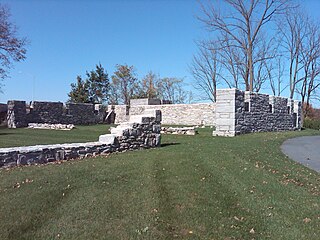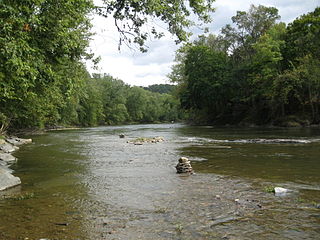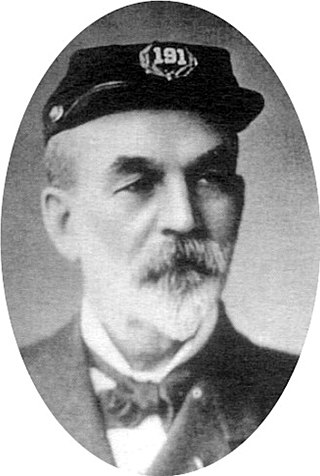
Knox Township is a township that is located in Clearfield County, Pennsylvania, United States. As of the 2020 United States Census, the population was 599.
The Battle of Devil's Backbone, also known as the Action at Devil's Backbone, was a military engagement in the Trans-Mississippi Theater of the American Civil War. Devil's Backbone is a ridge in the Ouachita Mountains approximately 4 miles (6.4 km) southwest of Greenwood, Arkansas. The battle was fought on September 1, 1863, in Sebastian County, Arkansas. The Union victory ensured the safety of the Fort Smith garrison until the end of the war.
The Battle of Carlisle was an American Civil War skirmish fought in Pennsylvania on the same day as the Battle of Gettysburg, First Day. Stuart's Confederate cavalry briefly engaged Union militia under Maj. Gen. William F. "Baldy" Smith at Carlisle and set fire to the Carlisle Barracks. Stuart's cavalry withdrew and arrived at the Battle of Gettysburg, Second Day, to the annoyance and concern of Gen. Robert E. Lee.
The Department of the Susquehanna was a military department created by the United States War Department during the Gettysburg Campaign of the American Civil War. Its goal was to protect the state capital and the southern portions of the commonwealth of Pennsylvania, and to deny the Confederate army passage across the vital Susquehanna River.

Anderson Creek is a 23.6-mile-long (38.0 km) tributary of the West Branch Susquehanna River in Clearfield County, Pennsylvania, in the United States.

During the American Civil War, the Commonwealth of Pennsylvania played a critical role in the Union, providing a substantial supply of military personnel, equipment, and leadership to the Federal government. The state raised over 360,000 soldiers for the Federal armies. It served as a significant source of artillery guns, small arms, ammunition, armor for the new revolutionary style of ironclad types of gunboats for the rapidly expanding United States Navy, and food supplies. The Phoenixville Iron Company by itself produced well over 1,000 cannons, and the Frankford Arsenal was a major supply depot.

Florida participated in the American Civil War as a member of the Confederate States of America. It had been admitted to the United States as a slave state in 1845. In January 1861, Florida became the third Southern state to secede from the Union after the November 1860 presidential election victory of Abraham Lincoln. It was one of the initial seven slave states which formed the Confederacy on February 8, 1861, in advance of the American Civil War.

The "Battle of Fort Fizzle" was a skirmish fought on June 17, 1863, which took place during the American Civil War in the village of Glenmont in Holmes County, Ohio, between Union troops and local draft resisters opposed to the Conscription Act of 1863.

The Skirmish of Sporting Hill was a relatively small skirmish during the Gettysburg campaign of the American Civil War, taking place on June 30, 1863, at various locations in present-day Camp Hill, East Pennsboro Township and Hampden Township in Cumberland County, Pennsylvania. It is known as the northernmost engagement of Robert E. Lee's Army of Northern Virginia during the Civil War.

The 43rd Virginia Cavalry Battalion, also known as 43rd Virginia Rangers, Mosby's Rangers, Mosby's Raiders, or Mosby's Men, was a battalion of partisan cavalry in the Confederate Army during the American Civil War. Noted for their lightning strike raids on Union targets and their ability to consistently elude pursuit, the Rangers disrupted Union communications and supply lines.

The Skirmish at Island Mound was a skirmish of the American Civil War, occurring on October 29, 1862, in Bates County, Missouri. The Union victory is notable as the first known event in which an African-American regiment engaged in combat against Confederate forces during the war.

During the American Civil War, most of what is now the U.S. state of Oklahoma was designated as the Indian Territory. It served as an unorganized region that had been set aside specifically for Native American tribes and was occupied mostly by tribes which had been removed from their ancestral lands in the Southeastern United States following the Indian Removal Act of 1830. As part of the Trans-Mississippi Theater, the Indian Territory was the scene of numerous skirmishes and seven officially recognized battles involving both Native American units allied with the Confederate States of America and Native Americans loyal to the United States government, as well as other Union and Confederate troops.

The 4th North Carolina Infantry Regiment was a Confederate States Army regiment during the American Civil War, active from 1861 until the war's end in April 1865. Ordered to Virginia, the unit served in General Winfield S. Featherston’s, George B. Anderson’s, Stephen D. Ramseur’s, and William R. Cox’s Brigade. Its field officers were Colonels George B. Anderson, Bryan Grimes, Edwin A. Osborne, and James H. Wood; Lieutenant Colonels David M. Carter and John A. Young; and Majors Edward S. Marsh and Absalom K. Simonton. It was nicknamed "The Bloody Fourth" after the high rate of casualties at the Battle of Seven Pines.

The 91st Pennsylvania Volunteer Infantry was a Union infantry regiment which fought in multiple key engagements of the American Civil War, including the Battle of Fredericksburg, Battle of Chancellorsville and Battle of Gettysburg. It was established through the combined efforts of Edgar M. Gregory, who had received approval from the U.S. War Department to begin recruiting soldiers for an entirely new regiment during the fall of 1861, and Edward E. Wallace, who had initiated his own recruitment efforts that October. Their recruits were volunteers, the majority of whom initially enlisted for three-year terms of service from their hometown of Philadelphia; they were divided into 10 lettered companies upon muster in during early December 1861: A, B, C, D, E, F, G, H, I, and K.

The Fishing Creek Confederacy was an alleged military uprising in northern Columbia County, Pennsylvania and southern Sullivan County, Pennsylvania during the American Civil War. Residents of Columbia County strongly opposed military drafts that were being conducted there, leading to widespread desertion and draft evasion. In a Columbia County draft in July 1863, 618 people were drafted. Of these, approximately 75% evaded the draft. On July 30, 1864, several people rode into northern Columbia County from Luzerne County to search for deserters, and one of the riders was shot. By the summer of 1864, rumors had begun to circulate that these deserters and draft evaders, as well as Confederate sympathizers, had built a fort with cannons on North Mountain, not far from the headwaters of Fishing Creek. This fort was supposedly manned by 500 people. Upon hearing these rumors, 1000 soldiers gathered near Bloomsburg, in Columbia County.

The 202nd Regiment Pennsylvania Volunteer Infantry was an infantry regiment of the Union Army in the American Civil War. Raised in the Harrisburg area and the Coal Region in August and September 1864, the regiment was sent to the Manassas Gap Railroad to guard it against the attacks of Confederate partisan rangers led by John Mosby. Following the Union victory at Battle of Cedar Creek, the regiment helped break up the now unneeded railroad and moved to Alexandria to guard the railroad there. After the end of the war, the regiment served in the Coal Region to suppress labor unrest, and was mustered out in mid-1865.

Wallace W. Johnson was a soldier from Pennsylvania who fought in the American Civil War. He received the United States' highest medal for bravery during combat, the Medal of Honor, for his actions during the Battle of Gettysburg 2 July 1863. He was issued the medal on 8 August 1900.
Thaddeus Stevens Smith was a soldier from Pennsylvania who fought in the American Civil War. He received the United States' highest medal for bravery during combat, the Medal of Honor, for his actions during the Battle of Gettysburg 2 July 1863. He was issued the medal on 5 May 1900.

J. Levi Roush was an American soldier who fought with the Union Army in the American Civil War. Roush received his country's highest award for bravery during combat, the Medal of Honor, for actions taken on July 2, 1863, during the Battle of Gettysburg.
The 6th Mississippi Infantry Regiment was a unit of the Confederate States Army that fought in many battles of the Western theater of the American Civil War. After taking heavy casualties at the Battle of Shiloh, the 6th Regiment fought in the Vicksburg Campaign, operations against anti-Confederate guerillas in Jones County, Mississippi, the Atlanta campaign, and the Franklin-Nashville campaign.














